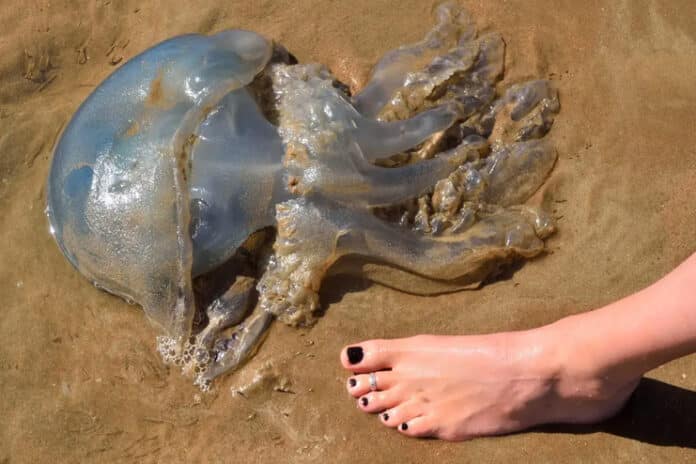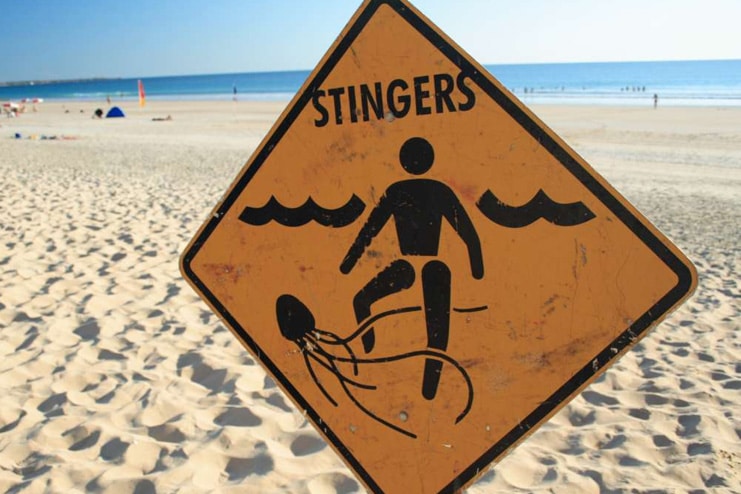Affiliate Disclaimer
Some links in this article are affiliate links. We may earn a small commission if you make a purchase through these links, at no extra cost to you. We only recommend products we find useful to our readersInjuries are common among those who wade, dive, or swim in seawater, and one such injury is a jellyfish sting. While not usually a serious medical condition, jellyfish stings can be troublesome in some cases and may require proper treatment.
There are also several home remedies that can provide relief from jellyfish stings. Keep reading this HealthSpectra article to learn everything you need to know about jellyfish stings.
What Are Jellyfish Stings and What Causes Them?
Jellyfish are non-aggressive, free-swimming marine animals with a gelatinous body and tentacles covered in sacs called nematocysts, which contain venom. When swimmers encounter these tentacles in seawater, the nematocysts release venom through microscopic barbed stingers. This can cause pain and, in some cases, be life-threatening.
Types Of Jellyfish:
The severity of a jellyfish sting may depend on the type of jellyfish encountered:
- Box jellyfish (found in warm waters of the Pacific and Indian oceans) cause intense pain and are life-threatening due to their toxic venom. This leads to cardiac arrest or death within a few minutes
- Portuguese man-of-war or bluebottle jellyfish (found in warmer seas) have a blue or purplish gas-filled bubble that acts as a sail, keeping the fish afloat on the water. Their tentacles give painful stings, causing welts, nausea, and sometimes, systemic allergic reactions
- Sea nettle (common in both warm and cold sea waters) is abundantly found along the northeast coast of the US and the Chesapeake Bay. Its sting is not typically dangerous. However, it can cause skin irritation, burning, and redness, which usually lasts for several hours
- Lion’s mane jellyfish (the world’s largest jellyfish) are common in cooler, northern regions of the Pacific and Atlantic oceans. The body diameter of these fish is over 3 feet. Their stings cause pain, redness, and swelling but are rarely life-threatening. They are risky for people with allergies or sensitivities
The blisters or shallow sores/ulcers formed by jellyfish at the sting site may look bluish-purple and dusky. These may heal in weeks, but the chances of permanent scars at the affected site may be high.
Often, jellyfish stings result in immediate pain, irritation, and red marks on the skin. Sometimes, whole-body (systemic) illness also develops. In rare cases, jellyfish stings turn life-threatening. Home treatment is enough to improve most jellyfish stings, but severe reactions require emergency medical care.
The main factors that lead to varied severity include:
- The potency of the venom and the type of the jellyfish
- During warmer months (spring and summer) the venom gets stronger
- One’s age, general health, and size
- The extent of the stung body surface
- The number, size, and location of the body where the jellyfish stung
Symptoms of Jellyfish Stings
The symptoms of jellyfish stings vary. They may be severe or mild and immediate or delayed. In most cases, the healing is slow. The pain from Portuguese man-of-war stings is intense and lasts for hours. The stings of jellyfish or sea anemone larvae develop rashes called Seabather’s eruption.
More symptoms can include:
- Shock and pain
- Swelling in the throat, mouth, lips, tongue, mouth, ears, neck, feet, eyelids, palms
- Swelling interfering with the airways
- Difficulty breathing
- Wheezing
- Coughing
- Confusion
- Lightheadedness
- Vertigo
- Vomiting
- Diarrhea
- Stomach cramps
- Chills
- Hives
- Muscle cramps or spasms
At times, days, weeks, or even a couple of months after the sting, skin rashes may develop, which are called delayed symptoms. These symptoms accompany other symptoms like:
- Fever
- Joint stiffness
- Weakness
- Swelling
- Itching
In such cases, the complications could subside by the medical treatment.
First Aid or Home Treatment for Jellyfish Stings
Home treatment is usually enough to eradicate skin irritation and rashes caused by minor jellyfish or Portuguese man-of-war stings. Below is a basic home procedure for treating jellyfish stings.
- Step 1: Remove the person from the water and wash the affected area with vinegar. The American Heart Association recommends rinsing the area with vinegar or baking soda for 30 seconds, which helps deactivate stinging cells
- Step 2: Pluck visible tentacles with fine tweezers
- Step 3: Immerse the leg or arm in hot water (104–113°F) for around 20 minutes, or let the person take a hot shower. If the affected area can’t be soaked in hot water, cold packs can be used as an alternative
- Step 4: Apply hydrocortisone cream or administer an antihistamine by mouth to relieve the jellyfish itch and swelling. Follow-ups are essential
Note: Avoid unhelpful or unproven tips like scraping out stingers, rinsing with human urine or freshwater, applying meat tenderizer, alcohol, ethanol or ammonia, or pressure bandages. These are unproven and may cause further damage.
Treatment for Jellyfish Stings
Even though rashes like Seabather’s eruption are uncomfortable, they are not dangerous or serious medical conditions.
- Sores that are formed due to jellyfish stings may heal without treatment
- For less severe cases, over-the-counter pain relievers or ice packs can be used
- Open sores have to be cleansed thrice a day, and antibiotics must be applied
- In severe cases, the affected person may be hospitalized, and anti-venom medication may be administered to box jellyfish stings
- Deep sores require medical treatment to prevent any further infection
- A jellyfish sting near an eye needs immediate medical care for pain control and eye flushing
- In case of a severe allergic reaction (anaphylaxis) of the body system, emergency care is required
Note: If children put a part of the jellyfish tentacle in their mouth, they are at high risk of stings in the mouth or throat that cause sudden severe swelling and may become life-threatening.
How to Prevent Jellyfish Stings?
A way to prevent jellyfish stings is to avoid activities in the sea waters with jellyfish present in them. Other ways that can possibly help prevent jellyfish stings include:
- Wearing a Protective Suit: A wetsuit or other protective clothing can help when swimming or diving in areas with a high concentration of jellyfish. Stinger suits made of high-tech fabric and protective footwear work well while wading in shallow water
- Gathering Information: Collect as much information as possible from residents, lifeguards, or health department officials before attempting to swim in coastal waters where jellyfish are common. Plan to stay away from the water when the jellyfish count is high in any season
Conclusion
Spending time in the ocean can be enjoyable, but jellyfish may spoil the fun. To avoid jellyfish stings, exercise extreme caution when engaging in activities in the ocean, especially in areas where jellyfish are abundant.
Jellyfish stings can vary in severity, ranging from mild discomfort to life-threatening reactions, depending on the species and your individual health condition. Timely and appropriate treatment is essential—whether it’s at home for minor stings or emergency care for severe cases.
To prevent stings, take precautions such as wearing protective clothing, being aware of jellyfish activity in the area, and knowing basic first aid. Familiarize yourself with the causes, symptoms, and treatments for jellyfish stings, along with effective preventive measures.
If you experience discomfort or suspect a jellyfish sting, seek immediate medical attention to receive the proper treatment. Enjoy your water activities safely, and be prepared to handle any encounters that may pose a risk.
-
Jan 2018Written by Sumana Maheswari
-
Dec 2024Edited by Lakshmi Gayatri
In this Article


















